OPPY WOOD, 3rd May 1917 – The Hull Pals Attack
 After the fall of Vimy Ridge, the Germans withdrew to the high ground of Oppy Wood, North East of Arras, The Capture of Oppy Wood was an engagement between May and June 1917. The Germans were in possession of a fortified wood, to the west of the village of Oppy, which overlooked British positions. The wood was 1-acre in area and contained many German observation posts, machine-guns and trench-mortars. The aim of the attack was to remove this defensive obstacle and divert German resources away from the main offensive, planned at Messines, in early June 1917. In military terms, Oppy Wood was a diversionary attack, by the 92nd Brigade, of the 31st Division, during the Third Battle of the Scarpe (3–4 May). It was an attack on a half mile front, in unfavourable conditions, and against impenetrable German defences. It is also known as the Battle of Gavrelle. However, for the people of Hull, Oppy Wood, would be forever remembered as the place where the Hull Pals made their name. In fierce fighting around the village, 223 Hull men and Officers were killed on the 3rd May 1917, more men than any other. The attack failed and the final casualties totalled 326. The youngest recorded soldier to die was 17 year old Private, Edward Ingram, while the oldest killed, was 42 year old Corporal, William Bishop, both serving withe the 11th EYR.
After the fall of Vimy Ridge, the Germans withdrew to the high ground of Oppy Wood, North East of Arras, The Capture of Oppy Wood was an engagement between May and June 1917. The Germans were in possession of a fortified wood, to the west of the village of Oppy, which overlooked British positions. The wood was 1-acre in area and contained many German observation posts, machine-guns and trench-mortars. The aim of the attack was to remove this defensive obstacle and divert German resources away from the main offensive, planned at Messines, in early June 1917. In military terms, Oppy Wood was a diversionary attack, by the 92nd Brigade, of the 31st Division, during the Third Battle of the Scarpe (3–4 May). It was an attack on a half mile front, in unfavourable conditions, and against impenetrable German defences. It is also known as the Battle of Gavrelle. However, for the people of Hull, Oppy Wood, would be forever remembered as the place where the Hull Pals made their name. In fierce fighting around the village, 223 Hull men and Officers were killed on the 3rd May 1917, more men than any other. The attack failed and the final casualties totalled 326. The youngest recorded soldier to die was 17 year old Private, Edward Ingram, while the oldest killed, was 42 year old Corporal, William Bishop, both serving withe the 11th EYR.
The main British attacking forces in this battle were the 10th, 11th and 12th Battalions of the East Yorkshire Regiment, known as the ‘Hull Pals’. At 3.45am, under a bright moon, they advanced up a slope, in four waves, over difficult terrain, illuminated by German rockets and Very Lights. They faced Oppy Wood, which was elaborately fortified, and defended by experienced German troops. They struggled forward over three belts of barb wire entanglements. Unable to keep pace with their barrage, and were exposed to murderous German machine gun fire. Despite this, the Hull Pals continued to advance.

One company fought their way into Oppy village itself, while the rest were held up. After attacking three times, they were forced to withdraw under constant fire. During the action, 2nd-Lieutenant, John Harrison, of the 11th Battalion, silenced an enemy machine-gun post single handedly and was posthumously awarded the Victoria Cross. He was 26 year sold and before the war had been a record try scorer for Hull FC and a Hull School Teacher.
Preparations for the attack on Oppy began on the 1st May 1917. Officers and NCO’s of the 10th and 13th EYR, went forward to check the assembly positions and returned next morning to issue equipment for the advance. At 11pm on the 2nd May, the 11th and 12th EYR Battalions started to move to their assembly positions. The 10th EYR moved at 11.30pm. Start time for the attack was to be 3.45am on the 3rd May, with the 10th EYR positioned on the right flank, the 11th EYR in the centre and the 12th EYR on the left flank, all opposite Oppy Wood. A preliminary bombardment by nine Field Artillery Brigades and the use of extra machine guns was expected to cut the barb wire, neutralise all German resistance and leave the trenches intact for the Pals to occupy. In reality, this failed to happen for a number of reasons.
1. On the 28th and 29th April, the Battle of Arleux had been fought on the same battleground and the 13th EYR had suffered a number of casualties. The assembly positions which had been heavily shelled, offered little cover and debris from that battle littered the ground, hindering coordinated movement. The 10th EYR Battalion history records that the assembly trenches were “barely four feet deep, with no communications to the rear, nor any means of contact to left or right.”
2. Oppy Wood was full of fallen trees and tangled branches which gave the enemy great cover. A long slope of 1,000 metres to the west, left the British field artillery at extreme range. This reduced its accuracy and largely failed to cut the enemy wire.

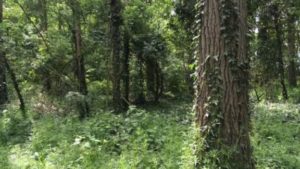
3. Oppy wood was a strongly defended position, guarded by the elie German soldiers. In front of Oppy Wood, lay a well organised trench system, protected by barb wire and good communications, which covered the Oppy wood and village from flanking attacks. The wood itself contained a large number of machine gun posts and all along the German lines, machine gun posts and mortars were well placed to repel any attack. The area was held by the 1st and 2nd German Guards, which the East Yorkshire Regimental history describes as, ‘some of the bravest of the enemy troops’. The Germans had strengthened the wood by developing defensive tactics learnt from the earlier Somme battles. The British had expected to encounter demoralised troops and thought that the creeping barrage would neutralise all resistance. However, some of the German wire at the south-western corner of the wood was uncut and rather than being shaken, the Germans were actually massing for a counter attack.
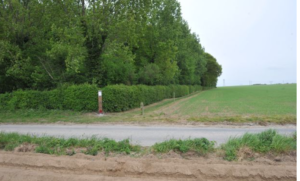
4. It was originally intended to make a night assault, to evade German machine-gun fire. However, the Third and First armies needed to attack in daylight and Douglas Haig enforced a compromise zero hour of 3:45am. No preparations had been made for an advance at night, such as, putting out boards, luminous paint on the German wire, taking compass-bearings or organising intermediate objectives. Sunrise was not until 5:22am and it would not be possible to see objects in the dark, at 50 yards (46 m) until 4:05am.
5. On the night of the attack, there was a full moon which did not set until sixteen minutes before the attack began. On many parts of the front, British troops assembling, were illuminated by the moon, exposing them to enemy fire. The 11th EYR war diary records “to get to the assembly positions, Companies had to go over the top of a rise within 1000 yards, with a moon low in the sky behind them.”
6. The German defenders saw the British infantry forming up in the moonlight, in an assembly trench just 250 yards (230 m) in front of them. At midnight, the German’s sent out a patrol and at 12:30am, bombarded the British lines for twenty minutes. They then began a second bombardment from 1:30am, until zero hour. The German bombardment then increased, when the British preliminary bombardment began and increased again when the attack started. Before whistles were blown to signal the attack , the 11th EYR were laying out in the open, under a heavy bombardment, for over two hours. There were few British casualties, but the shelling caused considerable confusion, with A and D companies of the 11th EYR companies unable to form into their attacking positions.

The 13th East Yorkshire Diary (Hull T’others), records “Our barrage started at 3.45am advancing at a rate of 100 yards, every four minutes and the Battalion followed 50 yards behind the barrage. It was dark, from the smoke and dust caused by our barrage, and the hostile barrage, also the fact that we were advancing on a dark wood made it impossible to see when our barrage lifted off the German trench. Consequently the Hun had time to get his machine guns up. Machine guns were firing from within the wood from trees, as well as from the front trench, nevertheless the men went forward, attacked and were repulsed. Officers and NCO’s, reformed their men in No Man’s Land, under terrific fire and attacked again, and again were repulsed. Some even attacked a third time, some isolated parties got through the wood to OppyVillage and were reported there by aeroplanes at 6am. These men must have been cut off and surrounded later. The Battalion was so scattered and the casualties had been so heavy that it was decided to consolidate the only assembly trench we had when the battle started.” At 10pm the battalion was finally relieved by the 11th East Lancs and retired back to camp for a short rest. Private, Surfleet, of the 13th EYR, had the grim task of helping to collect the dead and wounded. “There were dozens of dead bodies about” he wrote, “We collected all we could and stacked them in piles ready for removal to a decent burial further back. I am still amazed at the casual way we piled those bodies like so many huge logs, without any sense of horror at such a gruesome task.”
The 12th East Yorkshire Regiment (Hull Sportsmen), were also spotted moving up to their assembly trench and were heavily bombarded. Their War Diary writes: “The assembling took place in brilliant moonlight over quite unknown country and with four guides (from the 13th EYR). The enemy evidently saw the troops assembling and put up an intensive barrage followed by another one later. This considerably distinguished things and at zero hour, the blackest part of the night, the troops moved forward to the attack.” The first wave of the 12th EYR entered the German front line trench, which was strongly held, the second wave followed, but was forced to withdraw and eventually the first wave was beaten back out of the enemy line. Under heavy shell fire the 12th EYR to withdraw to their original assembly trench, where they remained all day, under heavy shelling and machine gun fire. They were later relieved during the night, on the 3rd/4th May, by the East Lancashire Regiment.”
The 10th East Yorkshire Regiment (Hull Commercials), also suffered a “tremendous” barrage on their assembly-positions, just before zero hour, which caused much disorganisation. The darkness in this area was increased by Oppy Wood itself and meant that the infantry could not see their barrage lift. The 10th EYR, on the right found areas of uncut wire and lost many casualties when they bunched up at the gaps, before reaching the wood. All four company commanders were wounded and the smoke and dust made it impossible to see what was going on at the flanks, and indeed obscured the objectives. The struggle to secure the German first line meant that the allied barrage had moved far ahead of the small parties that penetrated the German front trenches. A considerable number of men from the 10th EYR got into and beyond the first German line, some even penetrated Oppy village itself. One gallant soldier even brought back eight German prisoners single handed. However, it was impossible to get forward to consolidate the line. Survivors from the 10th EYR, eventually withdrew to the original assembly trench where they started. Many troops were then cut off and captured, or forced back with many casualties. Many of the troops were stranded in ‘No Man’s land’ and had to wait all day under fire from snipers, machine-guns and artillery until nightfall, before completing the retirement. The 10th EYR war diary found it difficult to give an accurate account of the battle. “A considerable number of men undoubtedly crossed the German line and got some way forward and possibly in places reached the first objective.” It was discovered after the war that the majority of the 10th Hull Commercials, who had been taken prisoner during the attack, had actually advanced as far as Oppy village itself. Private, John Beeken, of the 10th EYR painted a vivid ecollection of the battleground in his memoirs. He wrote “We advanced to the attack. It was hell. Our shells were shreiking over us and bursting just in front. It was a creeping barrage advancing as we moved forward. The German shells were shreiking over us and busting behind. Machine gun fire swept the whole front. Different coloured Very Lights and rockets went up over the German line. Everything looked so weird in the fumes from the shells. Although we were only about 100 yards away from Oppy Wood, I couldn’t see it for a mist had descended. The fumes almost choked us and I had a splitting headache. As we walked on we saw a number of dead lying about.”
The War Diary of the 11th East Yorkshire Regiment (Hull Tradesmen), describes some of the challenges faced by the attackers. “It was dark, the smoke and dust caused by our barrage, and the hostile barrage, also the fact that we were advancing on a dark wood, made it impossible to see when our barrage lifted off the German trench” Consequently the Hun had time to get his machine guns up. Machine guns were firing from within the wood from the trees, as well as from the front trench, nevertheless, the men went forward, attacked and were repulsed.”
Hull Casualties
 The official figures from Battalion Diary records, report that the ‘Hull Commercials’ (10th EYR battalion) went into the attack with 16 Officers and 484 Other Ranks. Their losses were: 13 Officers and 223 Other Ranks.
The official figures from Battalion Diary records, report that the ‘Hull Commercials’ (10th EYR battalion) went into the attack with 16 Officers and 484 Other Ranks. Their losses were: 13 Officers and 223 Other Ranks.
At least 69 men were killed on the 3rd May, with 8 men dying of wounds and 6 Officers also lost. Some like Corporal, Richard Fay, 10th EYR, from 60 Subway Street, Hull, wounded in the chest, on the day was discharged on 20/12/1917 with 100% disability and died on 20/02/1919, aged 23. He has no war memorial.
The 11th EYR suffered at least 52 fatalities on the 3rd May 1917. Another 13 men died of wounds. Also, 9 Officers lost, killed and wounded. They included 2nd Lieutenant, Jack Harrison, 11th EYR who was posthumously awarded the Victoria Cross during the attack.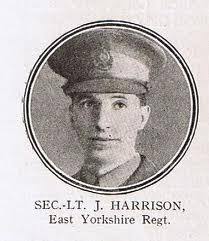
The 12th EYR initially reported two Officers and seven other ranks killed, 150 other ranks missing and one Officer and 127 other ranks wounded, plus one Officer dying of wounds. Later 116 men were confirmed killed on the 3rd May 1917. Another, 20 died of wounds and 5 Officers were killed or died of wounds. The losses suffered by the 12th EYR, were so great, that they resulted in it being reformed into only two companies. The remnants of A & C companies were attached to the 10th EYR and the remains of Companies B and D were sent to the 11th EYR.
The 13th EYR lost 10, killed men in the attack, including, Private, Walter James Barnes, who was Hull’s champion runner.
CWGC records show 239 men from the 10th, 11th, & 12th East Yorkshire Regiment, died at Oppy Wood, on the 3rd May 1917. Some 41 men and 20 Officers died of wounds.
Another 53 men from the 8th EYR, died on the same day, attacking the village of Monchy, ten miles away from Oppy.
At least 123 of the 280 Hull pals who died in the Oppy Wood Attack, have a known Hull connection (45%).
Another 29 Hull men, also died on the 3rd May 1917, fighting for other regiments. This meant a total of 152 Hull men were killed on the 3rd May 1917. They included 17 Hull men from the 8th EYR, 44 from the 10th EYR, 30 from the 11th EYR, 29 from the 12th EYR, and 3 from the 13th EYR, all killed on the 3rd May 1917. There would be many others who later died of wounds received on this day.
It was one of the worst days in the war for Hull, and the losses sent shock waves through the city.
Although the attack on Oppy Wood was repulsed with many British casualties, the operations did succeed in diverting German attention from the French front.
Oppy Wood was eventually captured on the 28th June 1917, with the East Yorkshires offering assistance. The 10th EYR formed the reserve Brigade, the 11th EYR held the front line with two companies and the 13th EYR was used for carrying parties.
Cadorna Trench Raid
The Hull Pals later carried out a successful raid on Cadorna Trench on the 23rd and 24th June 1917. The 10th, 11th, 12th and 13th East Yorkshire Battalions, each supplied two Officers and 50 other ranks for the raid, which was led by Lt, Col., Ferrand, from the 11th EYR. The raid was on a 40 yard front, with 50 yards between each battalion that attacked with rifle and bombing sections. Zero Hour was 10.20pm, with a heavy bombardment of the German trench, during which the raiders left their position in two lines. Immediately as the barrage lifted, the raiders rushed the German first and second lines. The raid captured 200 prisoners and killed some 280 enemy, destroying dugouts and machine guns on the way. The raid lost 24 men, including Captain Saville, Lieutenant Wright and 2/Lieutenant’s Cliff and Oliver killed. Another 16 men were killed in the raid with four dying of wounds later. Another 28 men returned from the raid wounded. Sergeant Marritt won the DCM, but was killed on the raid.
Total Casualties
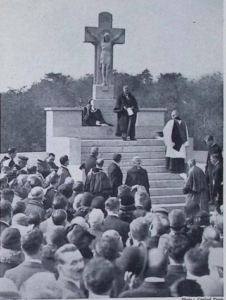
On 3 May, the 31st Division lost 1,900 casualties in the attack on Oppy Wood. The 2nd Division composite brigade had 517 losses, which left the division “bled white” with a “trench strength” of only 3,778 men. The CWGC, records that 580 men of the East Yorkshire regiment died during May and June 1917, and 7,815 men from the East Yorkshire regiment were killed in the war. Many of these men would have come from Hull and the East Riding, as seen by cross checking CWGC records, Soldiers Died records which show enlistment areas and the addresses of the dead compiled on this website.
On 8 May, the 5th Bavarian Division lost 1,585 casualties in the counter-attack at Fresnoy. In the attack of 28 June the 31st Division lost 100 men and the 5th Division casualties were 352 men.
Commemoration
- The units which attacked Oppy Wood were awarded the battle honour Oppy. A wood beside Dane Park Road, on the outskirts of North Hull, is named Oppy. It is a War memorial to the Hull Pals involved in the battle on the 3rd and 4th May, 1917.
- On the 16th October 1932, the people of Hull and the Commune of Oppy, unveiled a permanent memorial at the scene of the battle. The ground of which the memorial stands was donated by the Vicomte and Vicomtesse du Bouexic de la Driennays in memory of their 22 year old son Pierre, an NCO of the French 504th Tank Regiment, who was killed in action at Guyencourt on 8 August 1918.
- Oppy Wood, was also immortalised in paint, by war artist John Nash. It is held at the Imperial War Museum (reference ART 2243) and is entitled “Oppy Wood, Evening, 1917“. It is one of a series of paintings commissioned by the British War Memorial Committee set up by the Ministry of Information early in 1918 and is 2 metres high and wide. The lower half of the composition has a view inside a trench with duckboard paths leading to a dug-out. Two British infantrymen stand to the left of the dug-out entrance, one of them on the fire step looking over the parapet into No Man’s Land. There is a wood of shattered trees littered with corrugated iron and planks at ground level to the right of the composition. The sky stretches above in varying shades of blue with a spectacular cloud formation framing a clear space towards the top of the composition.
- Here is a letter from a survivor of Oppy Wood, published in the Hull Daily Mail, on the 3rd May 1926. https://www.forces.net/news/100-years-oppy-wood-horrors-revealed-survivors-letter


The magnificent Oppy memorial to the men of Kingston-upon-Hull and all local units, who gave their lives in the Great War: Many of the casualties of 31st Division, who died at Oppy, were from the Hull area.
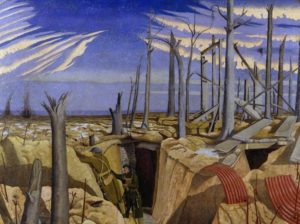
1 thought on “Oppy Wood, Arras, France 1917”